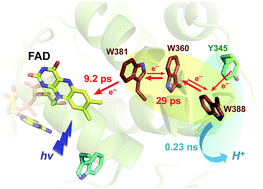Delocalized hole transport coupled to sub-ns tryptophanyl deprotonation promotes photoreduction of class II photolyases†
Abstract
Class II photolyases utilize for the photoreduction of their flavin cofactor (FAD) a completely different tryptophan triad than most other photolyases and cryptochromes. To counter sped-up back electron transfer, they evolved an unusually fast deprotonation of the distal tryptophanyl radical cation (WH˙+) that is produced after excitation of the flavin. We studied the primary aspects of oxidized FAD photoreduction by ultrafast transient absorption spectroscopy, using the class II photolyase from Methanosarcina mazei. With a time constant of 9.2 ps, the initial reduction step of the excited flavin by the proximal W381 tryptophan proceeds almost twentyfold slower than in other photolyases carrying oxidized FAD, most likely because of the larger distance between the flavin and the proximal tryptophan. The thus formed W381H˙+ radical is tracked by transient anisotropy measurements to migrate in 29 ps with delocalization over several members of the tryptophan triad. This 29 ps phase also includes the decay of a small fraction of excited flavin, reacting on a slower timescale, and partial recombination of the FAD˙−/WH˙+ radical pair. A final kinetic phase in 230 ps is assigned to the deprotonation of W388H˙+ that occurs in competition with partial charge recombination. Interestingly, we show by comparison with the Y345F mutant that this last phase additionally involves oxidation of the Y345 phenolic group by W388H˙+, producing a small amount of neutral tyrosyl radical (YO˙). The rate of this electron transfer step is about six orders of magnitude faster than the corresponding oxidation of Y345 by the deprotonated W388˙ radical. Unlike conventional photolyases, where the electron hole accumulates on the distal tryptophan before the much slower tryptophanyl deprotonation, our data show that delocalized hole transport is concomitantly concluded by ultrafast deprotonation of W388H˙+.



 Please wait while we load your content...
Please wait while we load your content...